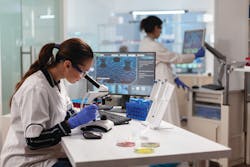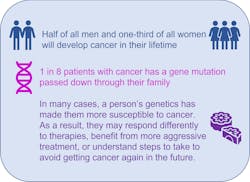Genetic disease testing — how it is evolving
Molecular, or genetic, pathology is a cutting-edge discipline focused on the study and diagnosis of disease through the examination of molecules within organs, tissues, or bodily fluids.1 Molecular pathology is similar to, and overlaps, some disciplines of anatomic pathology and clinical pathology, molecular biology, biochemistry, proteomics, and genetics. It is a practice that combines molecular and genetic testing and interpretation of patient cases to the predictive biomarkers that help identify specific responses to treatments. 2
Genetic Testing
Genetic testing can be used to determine a person’s potential for developing a specific disease based upon hereditary factors; it can also be used to accurately diagnose and determine the stage and type of a specific tumor (or disease) and provide key information on the potential patient response to specific treatments based upon genetic factors. The results of a genetic test can also confirm or rule out a suspected genetic condition or help determine a person’s chance of developing or passing on a genetic disorder. There are currently more than 75,000 genetic tests used by laboratories in routine practice, and they often bridge many different areas of healthcare, including pediatric, adult, and obstetric medicine.
Genetic testing looks for changes in the following:
- Genes: Gene tests study DNA sequences to identify variations in genes that can cause or predict increased risk for a genetic disorder. Gene tests can be narrow or large in scope, analyzing an individual nucleotide, one or more genes, or a person’s genome.
- Chromosomes: Chromosomal genetic tests analyze whole chromosomes to see if there are significant, identifiable genetic changes such as an extra, or a missing, chromosome.
- Proteins: Biochemical genetic tests study the quantity or activity level of proteins or enzymes; abnormalities in either are a predictor for changes to the DNA that may result in a genetic disorder.
Genetic, or molecular testing, is performed through PCR, qPCR, DNA sequencing, DNA microarray, among others.3 Historically, testing had been performed through DNA sequencing only. DNA sequencing, summarized below, can vary in scope:
- Targeted single variant: Single variant tests look for a specific variant in one gene. The selected variant is known to cause a genetic disorder. This type of test is often used to test family members of someone who is known to have a particular variant, to determine whether they have a familial condition.
- Single gene: Single gene tests look for any genetic changes in one gene. These tests are typically used to confirm, or eliminate, a specific diagnosis, particularly when there are many variants in the gene that can cause the likely finding.
- Gene panel: Panel tests look for variants in more than one gene. This type of test is often used to pinpoint a diagnosis when a person has symptoms that may fit a wide array of conditions, or when the suspected condition can be caused by variants in multiple genes.
- Whole exome sequencing/whole genome sequencing: Whole tests analyze the majority of an individual’s DNA to find genetic variations. This type of testing is generally used when single gene or panel testing has not provided a clear or expected diagnosis.
- Chromosomal: Chromosomal tests analyze whole chromosomes to identify sizeable changes. These changes can include missing, extra, or malformed chromosomes whether singular or segments.
- Gene expression: These tests look at which genes are expressed in cells. When a gene is active, the cell produces mRNA which dictates how proteins are produced. Gene expression tests study the mRNA in cells to determine which genes are active. Both overexpression and underexpression of genes are usually predictive for genetic disorders, including cancer.
Genetic screening versus genetic diagnostic testing
Genetic screening tests differ from genetic diagnostic tests in that screening tests determine an individual’s risk of developing a genetic condition, while diagnostic tests identify and diagnose genetic conditions.
Genetic screening tests include:
- Noninvasive prenatal testing/screening
This screening test is used in utero to help determine the risk that a fetus will be born with certain genetic abnormalities.
- Newborn screening
Routine testing is performed on all newborns in the United States. This determines the risk for developing the more common genetic disorders.
Genetic diagnostic tests include:
- Molecular gene tests
These tests identify the order of nucleotides in an individual’s genetic code, a process called DNA sequencing. The purpose of these tests is to identify genetic changes that can cause disease.
- Chromosomal tests
Whole chromosomes are analyzed to identify sizeable changes such as missing, extra, or malformed chromosomes, whether singular or segments.
Digital pathology and AI-based methods
Digital pathology and image analysis algorithms can have a significant impact on diagnostic testing. The use of digital pathology and image analysis enables the identification and measurement of abnormalities in cell types quickly and accurately. It also efficiently and quantitatively evaluates histology and morphology of cells and tumors. It can easily identify and quantify patterns, changes, and abnormalities and highlight positive, or potentially positive, regions of interest. This supports not only diagnosis of disease, but also has the ability to determine the presence of metastasis.
Incorporating artificial intelligence (AI) supports the ability to mine large, unseen areas of images, which supports precision medicine and predictive responses to therapies based upon the image, the cell type, and quantitative information provided by genetic testing. This has roots that expand into research, clinical trials, and drug discovery. AI-based methods are being deployed in routine biomarker discovery and help pathologists better determine companion diagnostics specific to a patient and the diagnosis for that patient.
AI algorithms provide consistent, repeatable, proven results. It is an acknowledged fact that humans can generate inconsistent outputs and results through traditional testing — both between themselves and when their results are compared to those of their peers. AI–based approaches provide advantages over traditional methods by generating precise, unbiased, and consistent outputs and results.
AI algorithms provide the ability to easily compute items of a quantitative nature — computers have been doing this for decades and are designed for this — they do it much better, faster and more reliably than a human can. Al takes considerable time and burden off the pathologist, freeing them to be able to focus on the data and information they are being presented from a medical perspective. In traditional workflows, pathologists spend a significant amount of their time counting and performing calculations — often in their heads. Giving a pathologist access to all the information that they need to interpret and diagnosis a case through a robust, automated digital pathology solution, in combination with integrated AI algorithms that help provide them with textual, visual, and contextual information, provides a much faster, more accurate outcome.
Conclusion
Digital pathology offers advantages over manual pathology through enhanced accuracy and precision, automation of data, and direct and instant communication abilities across patient, research, and provider lines. These advantages will improve clinical decision making, resulting in better outcomes for patients. I believe it will also decrease the time for drug discovery, new treatment options, and regulatory approvals.
References
- Harris TJR, McCormick F. The molecular pathology of cancer. Nat Rev Clin Oncol. 2010;7(5):251-265. doi:10.1038/nrclinonc.2010.41.
- Cai HY, Caswell JL, Prescott JF. Nonculture molecular techniques for diagnosis of bacterial disease in animals: a diagnostic laboratory perspective. Vet Pathol. 2014;51(2):341-350. doi:10.1177/0300985813511132.
- Ke R, Mignardi M, Pacureanu A, et al. In situ sequencing for RNA analysis in preserved tissue and cells. Nat Methods. 2013;10(9):857-860. doi:10.1038/nmeth.2563.
About the Author

Lisa-Jean Clifford
Lisa-Jean Clifford has been a noteworthy leader in the high-tech healthcare solutions space for more than two decades. Lisa-Jean’s passion for making a positive impact on the lives of patients through technology can be traced back to her tenure at McKesson and IDX, now GE Healthcare, where she served in vital business development and marketing roles, and to Psyche Systems, an LIS solution provider, where she was the CEO for eleven years. She is currently the President at Gestalt Diagnostics.
Now, recognized as an industry expert, she actively participates in numerous boards including the Association of Pathology Informatics where she serves as President and MLO’s Editorial Advisory Board. She is widely published in many top laboratory publications and noteworthy news sources, such as Forbes, CAPToday, Medical Laboratory Observer, and Health Data Management. Also, she is a highly sought-after speaker and focuses on delivering valuable content in critical areas such as lab automation including software and interoperability, digital pathology, AI in pathology, lab informatics, oncology, and women’s health.

